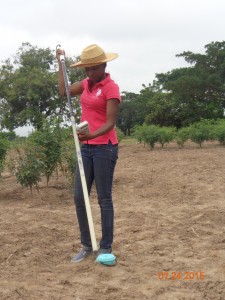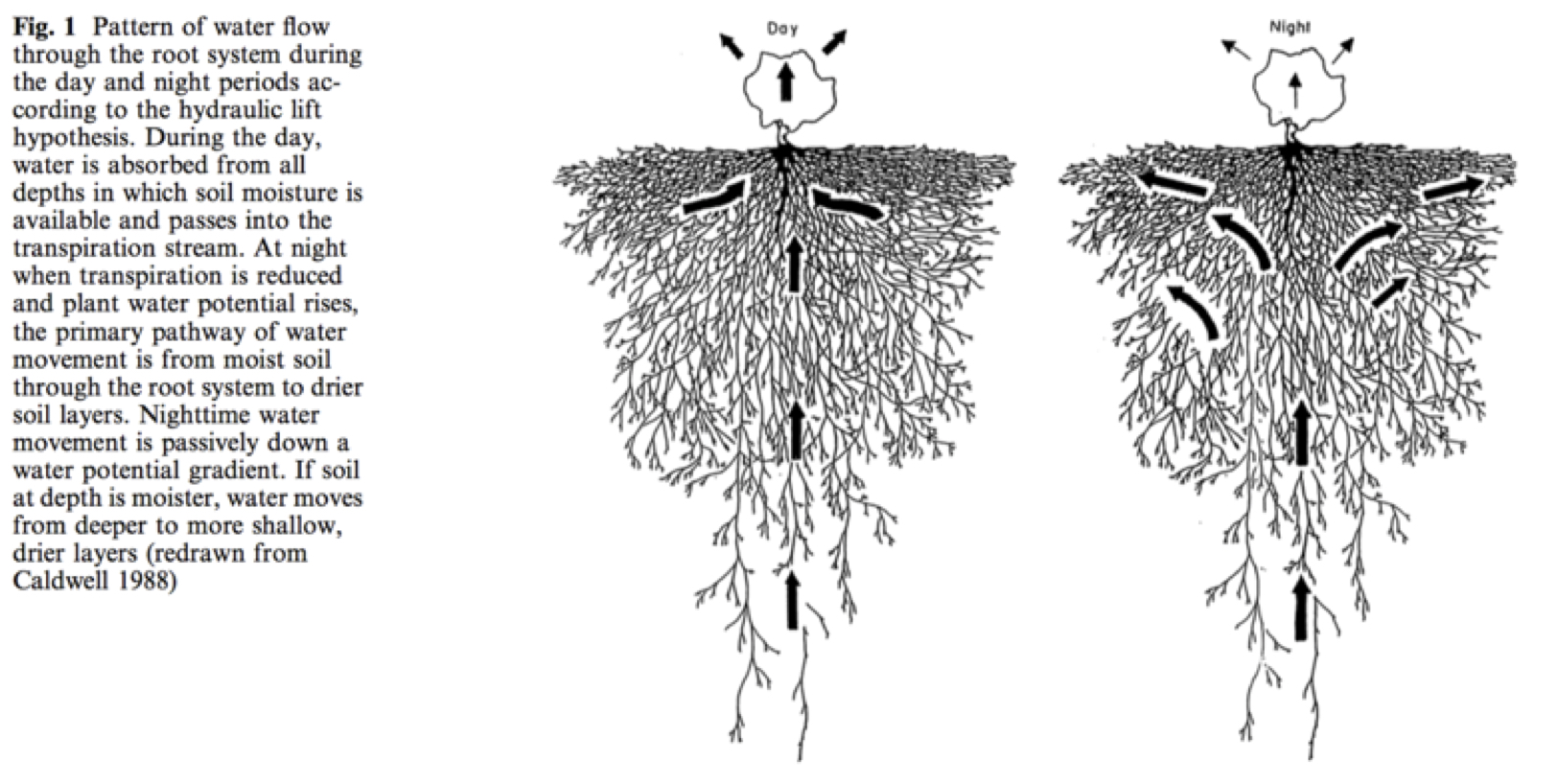Pigeon Pea- Hydraulic Lift
Description

Princess Adjei-Frimpong evaluating hydraulic lift.
Pigeonpea has been reported to possess a hydraulic lift function, giving the crop the potential to enhance the sustainability of farming systems in dry areas of sub-Saharan Africa. Hydraulic lift (HL) is the process of water uptake by some deep-rooted plants from deep down the soil profile to upper soil layers for shallow rooted plants to use. In simple terms, the plant roots function like a sprinkler pumping water to the soil surface. Some perennial and other desert shrubs with this function use it to regulate their water use and conserve water under conditions where water demand exceeds supply. HL is thus used by these deep-rooted plants as a mechanism to meet their water requirement for metabolism and growth. Water lifted hydraulically also helps meet the water demand of neighboring plants.
Pigeonpea (Cajanus cajan) is a multipurpose, tropical semi-perennial legume suitable for production in different agro-ecologies (Nam et al., 1993; Snapp et al., 2003). The plant generally has deep rooting system with extensive development in the upper 60 cm of the soil profile. This helps with its soil moisture extraction pattern and adaptation to rain-fed production environments (Natarajan and Willey, 1980; Chauhan, 1993). Studies have demonstrated that differences in rooting depths and root length densities in pigeonpea have implications for soil water extraction (Subbarao et al., 2000; Matsunaga et al, 1994). The long and medium duration cultivars have deep rooting systems which makes them well adapted to environments with varying soil moisture conditions. However, the extra-short duration is highly susceptible to drought stress, especially during flowering and pod-filling, due to its shallow rooting systems (Nam et al., 1993). The drought resistance in pigeonpea is also attributed to its osmotic adjustment, helping the plant to accumulate solutes within the plant tissue when there is a lower soil potential (WPs) thereby reducing the effects of water deficits (Flower and Ludlow, 1986; Ludlow and Muchow, 1990; Subbarao et al, 1995).
Water deficit negatively impacts plant performance, distribution and abundance (Dawson, 1993) and this has been implicated as the most important factor limiting carbon fixation, plant growth and global net primary production (Schulze, 1986). Therefore strategies such as hydraulic lift are needed by plants to cope with water deficit. The HL process has been described as the movement of water from the roots to the soil due to the difference between the root xylem potential and the surrounding soil potential when transpiration rates are low. This process is nocturnal, and the lifted water is reabsorbed by the roots the following day as part of the daily transpiration (Caldwell et al., 1998). Much of the work on HL has been documented mostly in the field with shrubs and trees (Caldwell and Richards, 1989; Dawson, 1993; Richards and Caldwell, 1987; Wan, et al., 1993) and rangeland grasses (Caldwell, 1990). A number of studies, however, have indicated that HL does occur in herbaceous species as well (Liste and White, 2008; Sekiya and Yano, 2004; Wan, et al., 2000; Xu and Bland, 1993).
HL may be beneficial to the plant conducting it, and also as an important source of water for the neighboring plant. The hydraulically lifted water utilized by neighboring plants has positive influence on their water use patterns and growth (Dawson, 1993). Some other implications of hydraulic lift include nutrient acquisition, biogeochemical nutrient cycling processes, and root growth and persistence (Caldwell et al., 1998). For example, an agricultural field trial by Sekiya and Yano (2004) showed that the introduction of a deep-rooted crop into the system allowed maize to utilize otherwise unavailable water sources deep in the soil layers. The cropping systems were maize (Zea mays)-pigeonpea and maize-sesbania (Sesbania sesban) intercrops. HL was only detected in pigeonpea though to date, this is the only report that indicates HL in pigeonpea. Princess Adjei-Frimpong is investigating how the hydraulic lift function in pigeonpea will limit water competition in a sorghum-pigeonpea cropping system and enhance the overall water-use efficiency of the system.
Principles:
Hydraulically lifted water has the potential to:
- Help neighboring plants survive drought stress
- Promote plant productivity
- Improve ecosystem water balance
- Enhance ecosystem nutrient cycling
- Enhances nutrients uptake by roots
Debates:
- How does the plant conducting this hydraulic lift benefit from the water lifted?
- To what extent is the hydraulically lifted water (HWL) able to stimulate growth of neighboring plants?
- What are the possible costs and benefits of hydraulic lift?
- What are the root properties regulating hydraulic lift?
- The mechanism of water release is not completely understood.
Learning Lab Research
The lab has an on-going trial in Ghana and Mali seeking to determine how the hydraulic lift function in pigeonpea will limit water competition in a sorghum-pigeonpea cropping system.
Extended Bibliography and Works Cited
Caldwell, M. M., Dawson, T. E., & Richards, J. H. (1998). Hydraulic lift: Consequences of water efflux from the roots of plants. Oecologia, 113(2), 151–161. doi:10.1007/s004420050363
Caldwell, M.M. et al. (1991). Hydraulic lift: ecological implications of water efflux from roots, in Plant Root Growth: An Ecological Perspective (Atkinson, D., ed.), pp. 423–436, Blackwell.
Caldwell M M 1990 Water parasitism stemming from hydraulic lift: A quantitative test in the field. Isr. J. Bot. 39, 395–402.
Caldwell, M.M. & J.H Manwaring. (1994) Hydraulic lift and soil nutrient heterogeneity. Isr. J. Plant Sci., 42, pp. 321–330
Caldwell, M. M., & Richards, J. H. (1989). Hydraulic lift: water efflux from upper roots improves effectiveness of water uptake by deep roots. Oecologia, 79(1), 1–5. doi:10.1007/BF00378231
Corak, S.J. et al. 1987. Water transfer in an alfalfa/maize association. Plant Physiol. 84, pp. 582–586.
Dawson, T.E. 1996. Determining water use by trees and forests from isotopic, energy balance, and transpiration analyses: the roles of tree size and hydraulic lift. Tree Physiol., 16, pp. 263–272.
Dawson, T. E. (1993). Hydraulic lift and water use by plants: implications for water balance, performance and plant-plant interactions. Oecologia, 95(4), 565–574. doi:10.1007/BF00317442
Dawson, T.E. (1993). Water sources of plants determined from xylem-water isotopic composition: perspectives on plant competition, distribution, and water relations, in Stable Isotopes and Plant Carbon/Water Relations (Ehleringer, J.R., Hall, A.E. and Farquhar, G.D., eds), pp. 465–496, Academic Press.
Emerman, S.H. (1996). Towards a theory of hydraulic lift in trees and shrubs, in Sixteenth American Geophysical Union Hydrology Days (Morel-Setoux, H.J., ed.), pp. 147–157, Hydrology Days Publications.
Emerman, S.H. & T.E Dawson. Hydraulic lift and its influence on the water content of the rhizosphere: an example from sugar maple, Acer saccharum. Oecologia, 108 (1996), pp. 273–278.
Flower, D. J., & Ludlow, M. M. (1986). Contribution of osmotic adjustment to the dehydration tolerance of water-stressed pigeonpea { Cajanus cajan ( L .) millsp .) leaves. Plant, Cell and Environment, 9, 33–40.
Liste, H. H., & White, J. C. (2008). Plant hydraulic lift of soil water – Implications for crop production and land restoration. Plant and Soil, 313(1-2), 1–17. doi:10.1007/s11104-008-9696-z
Ludlow, M. M., & Muchow, R. C. (1990). A Critical Evaluation of Traits for Improving Crop Yields in Water-Limited Environments. Advances in Agronomy, 43(C), 107–153. doi:10.1016/S0065-2113(08)60477-0
Matsunaga R, Ito O, Tobita S, Rao T. P, Johansen C. (1994). Effects
Matsunaga R, Ito O, Tobita S, Rao T. P, Johansen C (1994). Effects of transient waterlogging and nitrogen top-dressing on the shoot and root growth of short-duration pigeonpea. In: Ito O, Katayama K, Johansen C, Kumar Rao J.V.D.K, Adu-Gyamfi J.J, Rego T.J (eds). Roots and Nitrogen in Cropping Systems of the Semi-Arid Tropics. Cultio Corporation, Tsukuba, Ibaraki 305, Japan, pp 273-283.
Nam, N. H., Chauhan, Y. S., & Johansen, C. (1993). Comparison of Extra-Short-Duration Pigeonpea With Short-Season Legumes Under Rainfed Conditions on Alfisols. Experimental Agriculture, 29, 307. doi:10.1017/S0014479700020871
Natarajan, M., & Willey, R. W. (1980). Sorghum-pigeonpea intercropping and the effects of plant population density. The Journal of Agricultural Science, 95(01), 59. doi:10.1017/S0021859600029270
Richards, J. H., & Caldwell, M. M. (1987). Hydraulic lift: Substantial noctural water transport between soil layers by Artemisia tridentata roots. Oecologia, 73(4), 486–489.
Schulze, E. (1986). Vapor exchange in response to drought in the atmosphere and in the soil. Ann Rev, Plant Physiol, 37 (1986), pp. 247–274.
Sekiya, N., & Yano, K. (2004). Do pigeon pea and sesbania supply groundwater to intercropped maize through hydraulic lift?—Hydrogen stable isotope investigation of xylem waters. Field Crops Research, 86(2-3), 167–173. doi:10.1016/j.fcr.2003.08.007
Snapp, S. S., Jones, R. B., Minja, E. M., Rusike, J., & Silim, S. N. (2003). Pigeon Pea for Africa: A Versatile Vegetable – And More. HortScience, 38(6), 1073–1079.
Subbarao, G. V., Chauhan, Y. S., & Johansen, C. (2000). Patterns of osmotic adjustment in pigeonpea – Its importance as a mechanism of drought resistance. European Journal of Agronomy, 12, 239–249. doi:10.1016/S1161-0301(00)00050-2
Subbarao G.V, Johansen C, Slinkard A. E, Nageswara Rao R. C, Saxena N. P, Chauhan Y. S (1995). Strategies for improving drought resistance in grain legumes. Crit Rev Plant Sci 14:469-523.
Wan, C., Sosebee, R. E., & McMichael, B. L. (1993). Does hydraulic lift exist in shallow-rooted species? A quantitative examination with a half-shrub Gutierrezia sarothrae. Plant and Soil, 153(1), 11–17. doi:10.1007/BF00010540
Wan, C., Xu, W., Sosebee, R. E., Machado, S., & Archer, T. (2000). Hydraulic lift in drougth-tolerant and -susceptible maize hybrids. Plant Soil, 219, 117–126.
Xu, X., & Bland, W. L. (1993). Reverse Water Flow in Sorghum Roots. Agronomy Journal, 85(2), 384. doi:10.2134/agronj1993.00021962008500020039x
Links:
West African Shrub Initiative: Native shrub intercropping – a climate smart innovation to remediate degraded soils and improve food and nutrition security across the Sahel of sub-Saharan Africa.
Challenges Addressed: Poverty and Food Insecurity, Soil Quality, Soil Fertility, and low Productivity, Climate Change.



